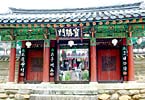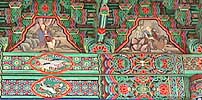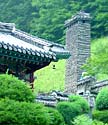
Haein-sa |
| Life in Korea rating: N/A |
Average member rating:
N/A (0 ratings) |
|
|
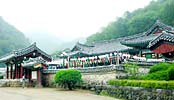  "Haein" means a reflection on the ocean and comes from a phrase of the
Avatamsaka sutra. Haein-sa is most famous for the Tripitaka
Koreana (woodblocks containing the entire teachings of Buddha) housed here. Two monks,
Sunung and Ijong, built the temple during the early 9th century to devote to studies
of the Sutra. The temple is one of the Sambosachal
(temples of three treasures) temples, along with
Songgwang-sa
and Tongdo-sa
"Haein" means a reflection on the ocean and comes from a phrase of the
Avatamsaka sutra. Haein-sa is most famous for the Tripitaka
Koreana (woodblocks containing the entire teachings of Buddha) housed here. Two monks,
Sunung and Ijong, built the temple during the early 9th century to devote to studies
of the Sutra. The temple is one of the Sambosachal
(temples of three treasures) temples, along with
Songgwang-sa
and Tongdo-sa
 
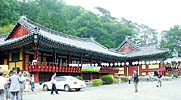 
 

 Haeinsa Iljumun (main gate)
Haeinsa Iljumun (main gate)
This gate serves as the grand entrance to Haein-sa. The phrase "Haeinsa temple at Mt.
Gayasan" is inscribed on the gate and has an autograph of Haegang Kim Gyu-jin.
Hongjeam Samyeongdaesa Pagoda and Budo
  Hongje-am ('am' means hermitage in Korean), where the Great Buddhist Monk Samyungdaesa resided,
was constructed in 1614, on Joseon Gwanghaegun for a shrine for Samyeongdaesa's portrait by monk Hyegudaesa.
Designated South Gyeongsang Tangible Cultural Properties #145, it contains Samyeongdaesa Pagoda and Budo.
Samyeondaesa Pagoda contains a record of Samyeongdaesa's life, written in 1612. It was destroyed in 1943
by a Japanese police chief and restored in 1958. Hongje-am's Samyeongdaesa Pagoda is the first constructed
pagoda of historical significance. Budo, the structure containing Samyeongdaesa's sarira, was constructed
1610 when Samyeongdaesa was died.
Hongje-am ('am' means hermitage in Korean), where the Great Buddhist Monk Samyungdaesa resided,
was constructed in 1614, on Joseon Gwanghaegun for a shrine for Samyeongdaesa's portrait by monk Hyegudaesa.
Designated South Gyeongsang Tangible Cultural Properties #145, it contains Samyeongdaesa Pagoda and Budo.
Samyeondaesa Pagoda contains a record of Samyeongdaesa's life, written in 1612. It was destroyed in 1943
by a Japanese police chief and restored in 1958. Hongje-am's Samyeongdaesa Pagoda is the first constructed
pagoda of historical significance. Budo, the structure containing Samyeongdaesa's sarira, was constructed
1610 when Samyeongdaesa was died.
  Taejeokkwangjon
Taejeokkwangjon
The main prayer hall of Taejeokkwangjon (designated as
South Gyeongsang Province Tangible Cultural Treasure #256) is dedicated to the Buddha of Immeasurable
Light (Vairocana). The original building was destroyed by fire and rebuilt in 1817, with
additional repairs completed in 1971. The building contains many images of Buddha with the attending
bodhisattvas of Manjusri and Samantabhadra.

 Stele for high priest Won-gyong Wangsa
Stele for high priest Won-gyong Wangsa
First erected in 1125 during the Goryeo Kingdom (918-1392), the stele was moved to this spot in 1961
from Panya-sa (where high priest Won-gyong Wangsa lived), and was
designated Treasure #128. According to the inscription, the priest's secular name was Shin Nak-chin.
Hhe became an abbot during the reign of King Sukchong and a royal teacher during the reign of King
Yejong. He died at the age of 70.
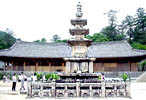  Three-story pagoda
Three-story pagoda
This three-story pagoda, typical of the Silla period (57 B.C.-A.D.935), is believed to have been built
during the ninth century. About 6 meters tall, it is one of the largest pagodas of that period. The
foundation was originally two stepped; a third part was added at the base when it was repaired in
1926. The cover stone of the upper part of the foundation is of a typical Silla style, as are the corner
pillars on the body and the five-stepped cornices of the roof stones. The pagoda is topped by a neat
finial. (Designated South Gyeongsang Province Tangible Cultural Property #254.)
  Stone Lantern
Stone Lantern
This stone lantern is believed to have been made towards the end of the Unified
Silla period (668-935). The middle part of the three-part pedestal supporting the fire chamber is a recent
replacement. The rest of the pedestal is ornately covered with lotus petals. The octagonal fire chamber
has four windows with four guardian figures carved between them. The roof stone is topped by an incomplete
finial. The stepping stone, which has a decorative pattern carved on its sides, must have been moved to the
present place inadvertently, for it is usually placed in front of a lantern rather than at its side.
(Designated South Gyeongsang Province Tangible Cultural Property #255.)
The Origin of Haksadae

 Go-un Choi Chi-won (A.D. 857-?) was a great scholar and writer during the
later part of the Silla Dynasty. At the age of 12, he went to China at the time of the Tang Dynasty, spent
17 years studying abroad, and rose to international fame through his excellent writings (such as
Tohwangsoyokmun which talks about the defeat of Hwangso's rebellion). He returned to Korea and served
as the governor of each respective county in turns. However, he was in agony between the social reality of
the day and his political ideal. So he came back to Nongsan-jong in the valley of Hangryudong
in Gaya-san and lived a life of seclusion. This place was
named Haksadae after his official rank.
Go-un Choi Chi-won (A.D. 857-?) was a great scholar and writer during the
later part of the Silla Dynasty. At the age of 12, he went to China at the time of the Tang Dynasty, spent
17 years studying abroad, and rose to international fame through his excellent writings (such as
Tohwangsoyokmun which talks about the defeat of Hwangso's rebellion). He returned to Korea and served
as the governor of each respective county in turns. However, he was in agony between the social reality of
the day and his political ideal. So he came back to Nongsan-jong in the valley of Hangryudong
in Gaya-san and lived a life of seclusion. This place was
named Haksadae after his official rank.
In his later years, he stuck his staff in the ground in front of his followers and said to them,
'As long as I live, this tree will also live. So devote yourselves to your
studies.' He then went quietly into the valley behind current day Hongjea and disappeared.
Legend says he became a Taoist hermit with supernatural powers. The fir tree alive today at Haksadae
is the same tree which came from his stick.
Admission: Included in Gaya-san National Park admission.
Directions: Olympic Expressway -> Haein-sa Interchange -> Gayasan towards Haein-sa, Local Road #1033 -> about 14 kilometers north -> Haein-sa
Open only during the following period:
May 1, 2005 ~ Dec. 31, 2006:
Mondays - 08:00-11:00, 12:00-17:00
Closed on Tuesdays, Wednesdays
* Cannot enter without cultural property guide.
Jan. 1, 2007 ~ Dec. 31, 2009: from Lunar New Year to 15th day of the 1st lunar month; from 15th day of the 3rd lunar month to the 14th day of the 4th lunar month, and from Jul. 15 to Oct. 15 of the solar calendar
See related tour(s). |
|
|
Member Comments:
No ratings posted yet.
Rate this destination
|
Transportation:
From the parking lot and bus depot, you will need to walk about 1.5 km to the temple itself.
Car: Take highway 9 ('88 Olympic Highway between Daegu and Gwangju) to the Haeinsa exit.
Follow the signs to Haeinsa. Park in the parking area just before Ch'iin-ri, the tourist resort
area for Haeinsa.
Bus: Several buses travel between Haeinsa and Daegu, Jinju, Masan, and Busan.
Train: No lines service Kayasan directly- the best method is to take a train to Daegu, then
take a taxi to the Seobu (west) intercity bus terminal and take a bus.
|
|

|
|

|
|








